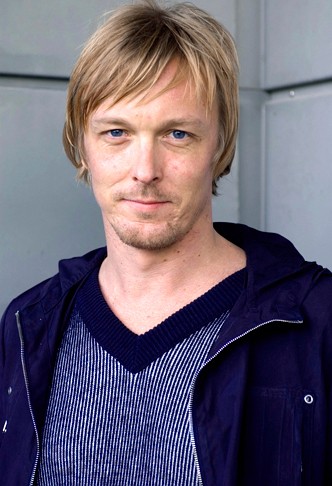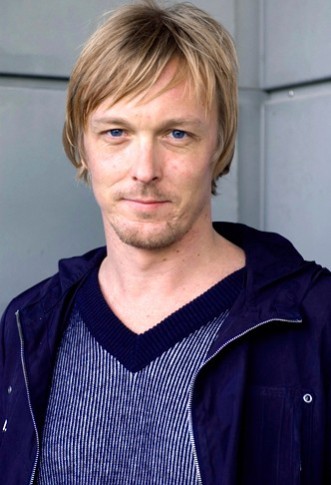
Jonas Dahlberg, 2005 Photo: Per-Anders Allsten/Moderna Museet
Interview with Jonas Dahlberg
Text by: Paulina Sokolow, Press Officer, Moderna Museet
As the artist behind the work Invisible Cities, do you have personal experience of living in an invisible city?
I grew up in Uddevalla and lived there until I was 20. But Invisible Cities is definitely not about Uddevalla, even if I obviously incorporated my experience of living there. Invisible Cities deals with a kind of forgotten “in-between” cities. Politics, newspapers, architectural magazines and so on discuss how the majority of the population nowadays lives in cities. They talk about the expansion of the new megacities and how the rural areas are being depopulated. But they hardly ever mention that a large part of the world’s population live in another kind of city. It is these invisible cities all over the world that are the subject of my poetic and conceptual examination. I have attempted to do this in a way that is both teasing and tender. In Italo Calvino’s Invisible Cities, Marco Polo tells Kublai Khan about his commercial travels around the world, but in fact describes his own home town over and over again. I have attempted the opposite – to describe the general invisible city and thus all the invisible cities of the world.
You also studied architecture, but you chose an artist career. Why?
I don’t really feel that I’ve chosen art, or given up architecture. I don’t think of what I do in terms of art, architecture or film. I use different media to study various issues that hopefully relate to what life is like today. The film Invisible Cities, which is screened at Moderna Museet, was recently included in the official programme at the Locarno International Film Festival, and Harry Gugger from Herzog de Meuron starts the autumn season this year by showing the film to his architecture students at masters level in Lausanne, who will follow it up with an urban planning project. One of the reasons why I gave up studying architecture in Lund was that I felt the pace was too fast and there was no time for reflection. The relationship between students and teachers was very hierarchical. In the course of a game of football in a park I happened to meet some people who went to what was called Forum in those days (Malmö Art Academy). Talking to them after the match I realised that I could apply to this new Art Academy for the same reasons I had applied to the course in architecture. I didn’t need to try to make art, I could simply do what I was interested in. At the Academy the pace was totally different. We discussed things with our teachers and professors as (more experienced) colleagues, and we got our own studio. The difference was enormous to my architectural studies. And it suited me so much better.
Two of your films will be shown at MM. One was made in an artificial landscape, the other in real settings. What do these films have in common?
Both films show a kind of urban landscape. One is, as you say, a model, but it almost looks real. The other city is real, but it looks almost like a model. And I guess they meet somewhere in between. Both are a form of generalised city. Some kind of archetype that the viewer will hopefully recognise without quite being able to identify them. Both films also have a dreamlike character, where the viewer’s position and seeing are vital elements in the work. They’re about seeing and being seen.
In 2004, you showed Invisible Cities at the São Paulo Biennale. Was the location relevant in any way to your work?
The São Paulo Biennale is held in a gigantic glass building designed by Niemeyer, and I worked on achieving a dialogue between the building and my presentation there. Glass as a material is a very physical manifestation of invisibility and visibility, and I used a kind of black glass (which I also use at Moderna Museet) that allows me to play with the viewer’s position, inside or outside, visible or invisible. So the building had a great impact. It was also inspiring to create a work about small cities, knowing that it would be exhibited for the first time in one of the world’s biggest megacities. This probably prompted me to work more on megacities and some of the issues involved. Megacities generate another kind of invisible city as they keep expanding and eating up the surrounding cities. Cities that previously had their own identity but are suddenly absorbed into a megacity, until only the name remains.
Explain what “Invisible Cities; Location Studies” is – the third of your works included in this exhibition?
This work was conceived when I travelled around by car on different occasions over a six-month period, visiting various invisible cities, to study the cities and find the ultimate invisible city to film. On these journeys I took loads of photographs and gradually also started taking pictures that would work as pictures, not just research material. In the Location Studies series I’ve erased the windows and various human elements. Since the person viewing the film, photograph and book is usually in a visible city, I have worked on reflecting the viewer’s own gaze. Showing them their own gaze. The gaze that turns things invisible. Because it’s only from the outside that the city is invisible. From within it is highly visible, compared to visible cities. So what viewers see is what is invisible to them. But they see the invisibility.
More about Jonas Dahlberg:

